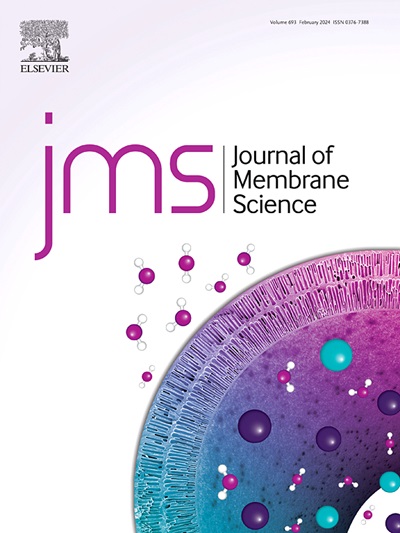Viologen based star copolymer membranes: Preparation and application in CO2/CH4 separation
IF 8.4
1区 工程技术
Q1 ENGINEERING, CHEMICAL
引用次数: 0
Abstract
The eight-armed star copolymer of polyhedral oligomeric silsesquioxane-based poly[(n-butyl acrylate)-co-1-(2-(((2-(acryloyloxy)ethyl)carbamoyl)oxy)ethyl)-1′-methyl-viologen hexafluorophosphate] [POSS-P(BA-co-VAP)8] containing a polyhedral oligomeric silsesquioxane (POSS) core and 8 arms of viologen based ionic P(BA-co-VAP) is prepared for carbon dioxide (CO2) separation. In the eight-armed star copolymer, the POSS segment affords great convenience for synthesis of eight-armed star copolymer via reversible addition fragmentation chain transfer (RAFT) polymerization and helps to improve the mechanical strength of the polymer membrane. The poly(n-butyl acrylate) (PBA) segment is hydrophobic and has a low glass transition temperature (Tg), which helps to form star copolymer nano-assemblies and also helps to form membrane at room temperature. The ionic poly[1-(2-(((2-(acryloyloxy)ethyl)carbamoyl)oxy)ethyl)-1′-methyl-viologen hexafluorophosphate] (PVAP) segment is crucial to form nano-assemblies and reversibly adsorb and desorb CO2 and to improve CO2 permeability and CO2/CH4 permselectivity. By casting the star copolymer nano-assemblies, porous membrane with pore size around 0.2–3.9 μm is prepared, and the prepared membrane exhibits a CO2 permeability of 636.3 Barrer and a CO2/CH4 permselectivity of 22.9, which is competitive to the previously reported polymer membranes.

求助全文
约1分钟内获得全文
求助全文
来源期刊

Journal of Membrane Science
工程技术-高分子科学
CiteScore
17.10
自引率
17.90%
发文量
1031
审稿时长
2.5 months
期刊介绍:
The Journal of Membrane Science is a publication that focuses on membrane systems and is aimed at academic and industrial chemists, chemical engineers, materials scientists, and membranologists. It publishes original research and reviews on various aspects of membrane transport, membrane formation/structure, fouling, module/process design, and processes/applications. The journal primarily focuses on the structure, function, and performance of non-biological membranes but also includes papers that relate to biological membranes. The Journal of Membrane Science publishes Full Text Papers, State-of-the-Art Reviews, Letters to the Editor, and Perspectives.
 求助内容:
求助内容: 应助结果提醒方式:
应助结果提醒方式:


